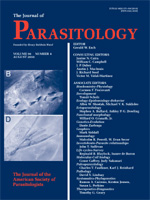Most strains of Toxoplasma gondii isolated in North America and Europe are grouped into 3 (Types I, II, III) genotypes and are considered clonal. Recent evidence suggests that illness due to toxoplasmosis in immunocompetent persons may be related to infection with an atypical genotype; these strains are mouse virulent. In the present study, a new mouse-virulent atypical T. gondii genotype was isolated from an asymptomatic black bear (Ursus americanus) from Alaska. The bear had a titer of 1∶1,600 using the modified agglutination test for T. gondii. Swiss Webster out-bred mice inoculated with bear heart homogenate died of acute toxoplasmosis, 12 days post-inoculation (PI). Cats fed tissues from chronically infected animals (day 30 PI) shed oocysts, but only 1 of 3 cats fed acutely infected mice (12, 16, 18 days PI) shed oocysts. The isolate (designated TgBbUS1) was mouse virulent; mice inoculated with 1 oocyst or 1 tachyzoite died of acute toxoplasmosis. The restricted fragment length polymorphism using 10 markers revealed that the strain possessed an atypical genotype: type I allele at loci SAG1, (5′-3′)SAG2, SAG3, c22-8, c29-2, L358, and Apico; type II allele at locus alt.SAG2; and type III allele at loci BTUB, GRA6, and PK1. DNA sequencing at intron loci EF1, HP2, and UPRT1 revealed that the TgBbUS1 is a divergent T. gondii strain. These results indicate that mouse-virulent atypical T. gondii genotypes are also circulating in wildlife in North America.
How to translate text using browser tools
1 August 2010
A New Atypical Highly Mouse Virulent Toxoplasma gondii Genotype Isolated from a Wild Black Bear in Alaska
J. P. Dubey,
C. Rajendran,
L. R. Ferreira,
O. C. H. Kwok,
D. Sinnett,
D. Majumdar,
C. Su
ACCESS THE FULL ARTICLE

Journal of Parasitology
Vol. 96 • No. 4
August 2010
Vol. 96 • No. 4
August 2010




